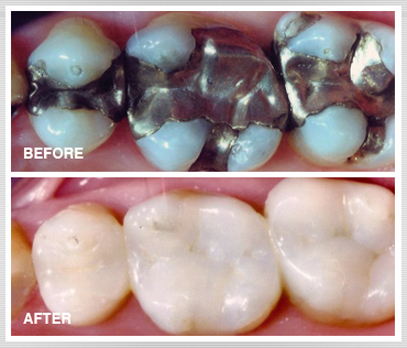
Composite or bonded fillings are a mixture of glass or quartz filler in a resin medium that produces a tooth-colored filling. They are sometimes referred to as composites or "tooth-colored fillings."  Composite fillings provide good durability and resistance to fracture in small-to-mid size restorations that need to withstand moderate chewing pressure. Less tooth structure is removed when the dentist prepares the tooth, and this may result in a smaller filling than that of other materials. Composites are chemically "bonded" or adhesively held in a cavity, often allowing the dentist to make a more conservative repair to the tooth.
Composite fillings provide good durability and resistance to fracture in small-to-mid size restorations that need to withstand moderate chewing pressure. Less tooth structure is removed when the dentist prepares the tooth, and this may result in a smaller filling than that of other materials. Composites are chemically "bonded" or adhesively held in a cavity, often allowing the dentist to make a more conservative repair to the tooth.
Composite bonding is an alternative to veneers, and can be used as a restorative procedure for teeth that are chipped, cracked, discolored or misarranged.
The cost is moderate and depends on the size of the filling and the technique used by the dentist to place it in the prepared tooth. It generally takes longer to place a composite filling than what is required for other materials. Composite fillings require a cavity that can be kept clean and dry during filling and they are subject to stain and discoloration over time.
How does it work?
The tooth is prepared for the procedure by lightly etching the surface and applying a bonding liquid. Once the liquid sets, a plastic resin is applied and sculpted into the desired shape by the dentist. Once set, the resin is trimmed, smoothed and polished to a natural appearance.

Considerations?
The bonding procedure can often be completed in a single office visit, and can improve the appearance of a tooth significantly. However, since the plastic resin used is not as strong as your natural tooth enamel, it is more likely to stain, chip or break than natural teeth. Depending on the size and location of the restoration, bonding typically lasts three to ten years before need of repair.

